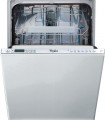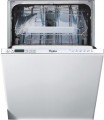Water consumption
The amount of water used by the dishwasher in one washing cycle. Usually, it is indicated for a standard cycle — at full load, without pre-rinsing, etc. Accordingly, in special modes, the consumption may differ from the indicated one.
The lower the consumption — it better; this is especially true for those who consume water by metres or who have a limited supply of water (for example, it is drawn from a well with a low productivity). On the other hand, a reduction in consumption can have a negative effect on the quality of the wash. So, choosing an
economical dishwasher, you should pay attention to the washing class (see below). In addition, only models of the same capacity can be compared in terms of consumption — after all, the more dishes, the more water is required to wash them.
Energy class
The energy efficiency class characterizes the the economy of a dishwasher's electricity consumption. Initially, the classes were denoted in Latin letters from A (high degree of economy) to G (high consumption). But later, with the development of energy saving technologies, more advanced classes than A appeared. They are denoted by the letter A with a certain number of pluses (
A+,
A++, etc.); the more benefits, the higher the economy. Most modern built-in dishwashers comply with energy classes from A to
A+++(the last is 30% more economical than the original class A). More high consumption models, such as classes B and C, are much rarer and gradually disappear.
More economical models cost more, but the difference can be recouped in energy savings. Also note that the energy consumption class does not describe efficiency in general, but in comparison with other similar models; therefore, the actual consumption of a small class A device may be lower than that of a large class A++ model.
Noise level
The approximate noise level produced by the dishwasher during operation. In modern models, this parameter can range from 37 – 39 dB (muffled human voice) to 59 – 60 dB (loud conversation); more detailed decoding of what sound corresponds to a particular number of decibels can be found in special tables. Anyway, the
low noise level contributes to the comfortable use of the device. It is especially important if the dishwasher is to be used at night (for example, if there are reduced electricity rates at night).
Number of programmes
The number of washing programs (modes) provided in the dishwasher. These programs may differ in duration, exposure intensity, water temperature, dish material (for example for delicate dishes), etc. For more information on the different options, see "Washing programs". And the more modes — the more advanced the device is, the more options it provides to choose from. But note that with the same number of programs, their specific set in different models may be different; these details should be clarified separately.
Washing modes
—
Own programme. Possibility to create and save a custom programme by setting the parameters to your liking. This function is convenient because instead of setting the washing settings manually each time, it is enough to save them once in the device’s memory and then simply select a user programme from the list.
—
Half load. A special programme for cases when the dishwasher is loaded with only half of its regular capacity. Running a full-fledged wash in such cases would be too wasteful; so in the half load mode, the dishwasher reduces the consumption of water, detergents and electricity, focus on a reduced amount of dishes. Such a programme is relevant mainly for roomy models (from 8 sets).
—
Pre-rinsing. The "soaking" mode is a program that rinses dishes with cold water and keeps them from drying for a long time, preventing food residues from sticking to the plates. It's useful for storing unwashed dishes for a long time, and for washing heavily soiled dishes without using intensive washing programs.
—
Quick wash. A quick wash programme that saves time. Designed mainly for lightly soiled dishes that do not require particularly intensive exposure; for cope with serious pollution is not suitable.
—
Automatic. This program allows the dishwasher to monitor the washing proc
...ess using sensors that evaluate the water composition during rinsing. The washing process ends when the water is free of impurities, ensuring optimal resource consumption. The washing mode varies by model, with some offering only standard automatic programs and others allowing users to choose the water temperature.
— Economical. A programme that reduces the consumption of water, detergents and electricity compared to a normal washing cycle. Usually, it is intended for dishes without heavy soiling and dried food residues, although individual models may have their own features of the economy mode.
— Delicate (for glass). Special programme for washing delicate dishes, especially that are made of thin glass (goblets, wine glasses, etc.). Washing is carried out at low temperatures (to avoid drops) and with minimal mechanical actions, which allows you to keep delicate dishes intact.
— Hygienic. This program is designed to destroy pathogenic bacteria and viruses effectively. It uses elevated water temperatures (around 68...70°C) that can provide a bactericidal effect without special detergents. This mode is useful for washing children's dishes and can be helpful when someone in the family is sick.
— Intensive. Special programme for washing heavily soiled dishes, such as pans with dried-on food residues. Usually, it provides increased pressure and elevated water temperature.
— Night(quiet). This program is designed for use at night or in situations where excessive noise is undesirable. It reduces the noise produced by the dishwasher by decreasing water temperature, pressure, and using other techniques depending on the model. The necessary washing efficiency is maintained by increasing the operating time, making it suitable for use at night.
— Steam treatment. Hot steam treatment can be used to soften dried food residues and sterilize jars and utensils for home canning. The process consumes a lot of energy.
In addition to the above, other types of programs may be indicated in the specs of dishwashers, in particular:
— Normal. Standard programme for washing lightly soiled dishes with a full load at temperatures around 65 °C. Available in almost all modern dishwashers, but sometimes manufacturers specify its availability separately.
— Plastic utensils. The programme is designed for washing reusable plastic dishes at lower temperatures and intensity than the standard programme to avoid scratches and damage caused by high heat. Not all plastic dishes are compatible with dishwashers, so compatibility should be checked separately. Washing disposable dishes is not recommended.
— Mixed. This category includes all programs that combine several washing modes at once — for example, the normal mode in the compartment for cups and glasses, and the intensive one in the lower part, where you can put a pot or frying pan. Options for such combinations may be different, depending on the model.
— Self-cleaning. Special programme to remove deposits and disinfect the dishwasher. Self-cleaning mode heats water with detergents to remove moderate pollution, and can be run multiple times for tough deposits.Beam on floor
The light indicator of work of the dishwasher. During the operation of the device, a special light mark is projected onto the floor in front of it; at the end of the programme, this mark goes out. Thus, one glance in the direction of the device is enough to determine its current state. And for fully integrated models (see "Type of installation"), this function is also convenient because it is no need to open the door to check the status of the device. Actually, the vast majority of units
with a "beam on the floor" are fully integrated.
Also note that in high-end dishwashers, not just a light mark in the form of a dot can be used, but a miniature projector, which is a
beam on the floor with a time indication or with other auxiliary information.
Hot water supply
Possibility of connection of the dishwasher to a source of hot water. With this connection, the water enters the device already heated (unlike the usual procedure, when the dishwasher itself heats the water to the desired temperature) — thus it saves time and energy. However, note that
"hot connection" is demanding on the quality of water: in most cases, it must have a temperature of 60-65 °C and be supplied without pressure drops.
Note that hot water connection is an option, not the only way; dishwashers with the possibility of such a connection can usually work according to the standard scheme, from a source of cold water.
Door closer
The presence of an
door closer in the design of the dishwasher.
An auto-closer is a device that helps close or open a door smoothly to the fully closed or open position, preventing the door from remaining in an intermediate position. It has two functions: ensuring the door is fully closed to prevent splashes and damage, and providing soft closing/opening to prevent shock and damage.

